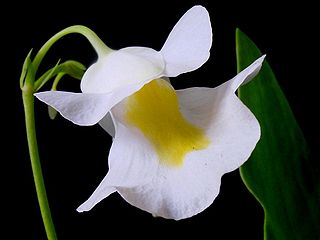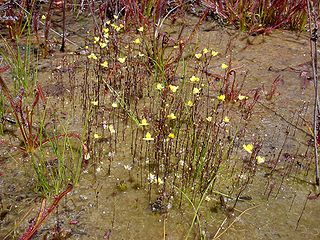
Utricularia subg. Utricularia is a subgenus in the genus Utricularia.
Utricularia naviculata is a very small, annual suspended aquatic carnivorous plant that belongs to the genus Utricularia. It is a very distinct species with relatively large bracts and unique trap-bearing shoots ("leaves"). U. naviculata is endemic to South America and is known only from the type location in Venezuela and a single collection in Brazil. It is found at low altitudes in slow-flowing or still waters. It has been found flowering in Brazil during the month of May and in Venezuela during August. It was first formally described by Peter Taylor in 1967.

Utricularia purpurea, the eastern purple bladderwort, is a medium-sized suspended aquatic carnivorous plant that belongs to the genus Utricularia. U. purpurea is endemic to North and Central America. It has been suggested that U. purpurea may have partially lost its appetite for carnivory. Richards (2001) did an extensive study in the field on it and noted that trapping rates of the usual Utricularia prey were significantly lower than in other species in the genus. Richards concludes that this species can still trap and digest arthropod prey in its specialized bladder traps, but does so sparingly. Instead, it harbors a community of algae, zooplankton, and debris in the bladders that indicates U. purpurea favors a mutualistic interaction in place of a predator–prey relationship.
Utricularia buntingiana is a small epiphytic, perennial carnivorous plant that belongs to the genus Utricularia. U. buntingiana is endemic to Venezuela, where it is only known from a few locations: the type location in Henri Pittier National Park, one collection on the Paraguaná Peninsula, and a few others from Falcón. It was originally published and described by Peter Taylor in 1975. Its habitat is reported as being mossy trees in montane forests at altitudes from 830 metres (2,723 ft) to 1,775 metres (5,823 ft). It has been seen flowering in June and July. Both U. buntingiana and U. praetermissa possess a double-curved corolla spur.

Utricularia campbelliana is a small epiphytic, perennial carnivorous plant that belongs to the genus Utricularia. U. campbelliana is endemic to northern South America, where it is found in Guyana and Venezuela and most likely also Brazil, though no positive records exist from that country. It was originally published and described by Daniel Oliver in 1887. It is named in honor of William Hunter Campbell, an attorney and amateur botanist who lived in Georgetown, Guyana. Its habitat is reported as being tree trunks, branches, and prop roots at altitudes from 1,500 metres (4,921 ft) to 2,500 metres (8,202 ft), but has been found at altitudes as low as 690 metres (2,264 ft). It has been seen flowering between August and April. In his 1989 monograph on the genus, Peter Taylor noted that at least one specimen has been recorded as being visited by a hummingbird and it is likely that both U. campbelliana and U. quelchii are bird-pollinated.
Utricularia podadena is a small, probably perennial, terrestrial carnivorous plant that belongs to the genus Utricularia and is the only member of Utricularia sect. Candollea. U. podadena is endemic to Malawi and Mozambique, being known only from the type location in Malawi and from one other collection in Mozambique. As of Peter Taylor's 1989 monograph on the genus, more recent efforts to locate this species have failed. It was originally published and described by Taylor in 1964 and placed in its own section, Candollea, in 1986. It grows as a terrestrial plant in marshy grasslands in the presence of Loudetia species at altitudes of around 1,000 m (3,281 ft). It flowers in July. It is a very distinct plant in the genus with the long stipitate glandular trichomes covering the flower. Its affinities within the genus are not clear.
Peter Geoffrey Taylor (1926–2011) was a British botanist who worked at Royal Botanic Gardens, Kew throughout his career in botany. Taylor was born in 1926 and joined the staff of the herbarium at Kew in 1948. He published his first new species, Utricularia pentadactyla, in 1954. In 1973, Taylor was appointed curator of the orchid division of the herbarium and, according to Kew, "under his direction, orchid taxonomy was revitalised and its horticultural contacts strengthened."
Utricularia steyermarkii is a small, probably perennial, bryophilous lithophyte carnivorous plant that belongs to the genus Utricularia. U. steyermarkii is endemic to Venezuela and is only known from three locations: the type location in the Venezuelan state of Bolívar, one other location from Bolívar, and also from Acopán-tepuí. It grows as a terrestrial lithophyte at the base of moist mossy bluffs. It has been collected in flower or fruit in February and May. It was originally described and published by Peter Taylor in 1967. It was named in honor of Julian Alfred Steyermark.
Utricularia mannii is a small, perennial, epiphytic carnivorous plant that belongs to the genus Utricularia and is the only member of Utricularia sect. Chelidon. U. mannii is endemic to tropical Africa, particularly the islands in the Gulf of Guinea and the adjacent mainland. It grows as an epiphytic plant on mossy tree trunks in rain forests at altitudes from 500 m (1,640 ft) to 2,100 m (6,890 ft). It has been collected in flower between April and November. It was originally published and described by Daniel Oliver in 1865 and placed in its own section, Chelidon, in 1986 by Peter Taylor.
Utricularia sect. Choristothecae is a section in the genus Utricularia. The two species in this section are very small rheophytic carnivorous plants that were formally included in section Avesicaria but were reassigned to their own section by Peter Taylor in 1989. He had included them in section Avesicaria largely because of the similar habit of the species, but the unique pollen morphology, dissimilar internal trap glands, and the anthers led Taylor to move these two species to section Choristothecae. Both species are endemic to South America, with Utricularia determannii only known from Suriname and Utricularia choristotheca located in French Guiana and Suriname.
Utricularia choristotheca is a very small, probably perennial, rheophytic carnivorous plant that belongs to the genus Utricularia. U. choristotheca is endemic to Suriname, where it is only known from the type location, and French Guiana, where it is found on Montagne des Nouragues. It grows as a rheophyte on bare granite rocks in dripping water at altitudes up to 900 m (2,953 ft). It has been collected in flower or fruit in July. It was originally described and published by Peter Taylor in 1986.
Utricularia determannii is a very small, probably perennial, rheophytic carnivorous plant that belongs to the genus Utricularia. U. determannii is endemic to Suriname, where it is only known from the type location in the Wilhelmina Mountains. It grows as a rheophyte on bare granite rocks in dripping water at altitudes up to 900 m (2,953 ft). It has been collected in flower in July. It was originally described and published by Peter Taylor in 1986 and named in honor of the American collector R. O. Determann.
Utricularia mirabilis is a small, perennial, rheophytic carnivorous plant that belongs to the genus Utricularia. U. mirabilis is endemic to Venezuela, where it is known from the type location near Campo Grande. It grows as a rheophyte in creek beds of shallow running water at altitudes around 1,500 m (4,921 ft). It has been collected in fruit and flower in December. It was originally described and published by Peter Taylor in 1986.

Utricularia subg. Bivalvaria is a subgenus in the genus Utricularia. It was originally described by Wilhelm Sulpiz Kurz in 1874. In Peter Taylor's 1989 monograph on the genus, he reduced the subgenus to synonym under section Oligocista, a decision that was later reversed in the light of molecular phylogenetic studies and the subgenus was restored.
Utricularia sect. Avesicarioides is a section in the genus Utricularia. The two species in this section are small rheophytic carnivorous plants native to western Africa. Sadashi Komiya originally described and published this section in his 1973 taxonomic treatment of the genus. Peter Taylor revised and refined the section in his 1989 monograph on the genus.

Utricularia sect. Nigrescentes is a section in the genus Utricularia. The three species in this section are small terrestrial carnivorous plants native to tropical Africa, Asia, and Australia. Daniel Oliver originally validly described and published this section in 1859, but did not specify the rank used by the group. Sadashi Komiya revised the section in 1973. Peter Taylor, in his 1989 taxonomic monograph on the genus, placed this section within subgenus Utricularia. More recent phylogenetic data and revisions have reinstated subgenus Bivalvaria and have placed this section within it.

Utricularia sect. Oligocista is the largest section in the genus Utricularia. The 42 species in this section are small to medium-sized terrestrial carnivorous plants native throughout the tropics, with six species in the Americas, ten in Africa, five in Australia, and the remainder in Asia, with 17 mostly native to peninsular India. Alphonse Pyrame de Candolle originally described and published this section in 1844. Peter Taylor published his taxonomic monograph of Utricularia in 1986, in which he placed this section within subgenus Utricularia. More recent phylogenetic data and revisions have reinstated subgenus Bivalvaria and have placed this section within it.
Utricularia garrettii is a small perennial carnivorous plant that belongs to the genus Utricularia. It is endemic to Thailand where it is only known from the type locality and represented by a single specimen. U. garrettii grows as a lithophyte on moist rocks at altitudes around 2,175 m (7,136 ft). It was originally described by Peter Taylor in 1986 from a collection by H. B. G. Garrett in 1910. As of Taylor's 1989 revision of his monograph, it had not been recollected since Garrett's original collection. It is most similar to U. striatula and can be easily confused for it.

Utricularia sect. Setiscapella is a section in the genus Utricularia that contains small or medium-sized terrestrial or subaquatic species. Most plants in this section are endemic to Central and South America with the exceptions of Utricularia stanfieldii, which is endemic to Africa, and Utricularia subulata which is almost pantropical. It was first described by John Hendley Barnhart in 1916 at the rank of genus. In 1973, Sadashi Komiya reduced the genus to a subgenus of the genus Utricularia. In his 1986 monograph on the genus, Peter Taylor reorganized the genus and reduced this to the rank of section.

The Genus Utricularia: A Taxonomic Monograph is a monograph by Peter Taylor on the carnivorous plant genus Utricularia, the bladderworts. It was published in 1989 by Her Majesty's Stationery Office (HMSO) as the fourteenth entry in the Kew Bulletin Additional Series. It was reprinted for The Royal Botanic Gardens, Kew in 1994.







